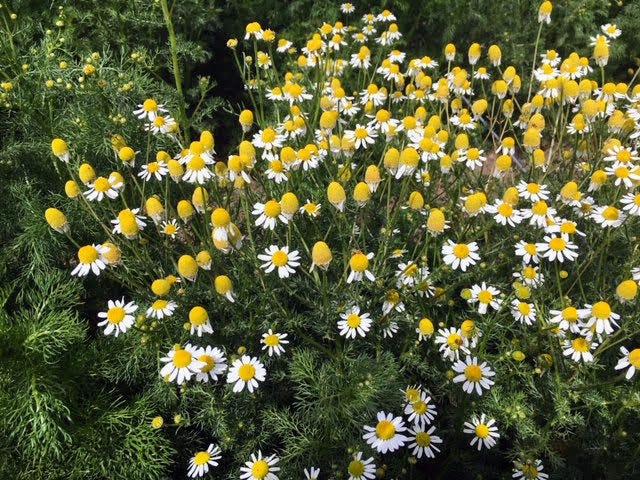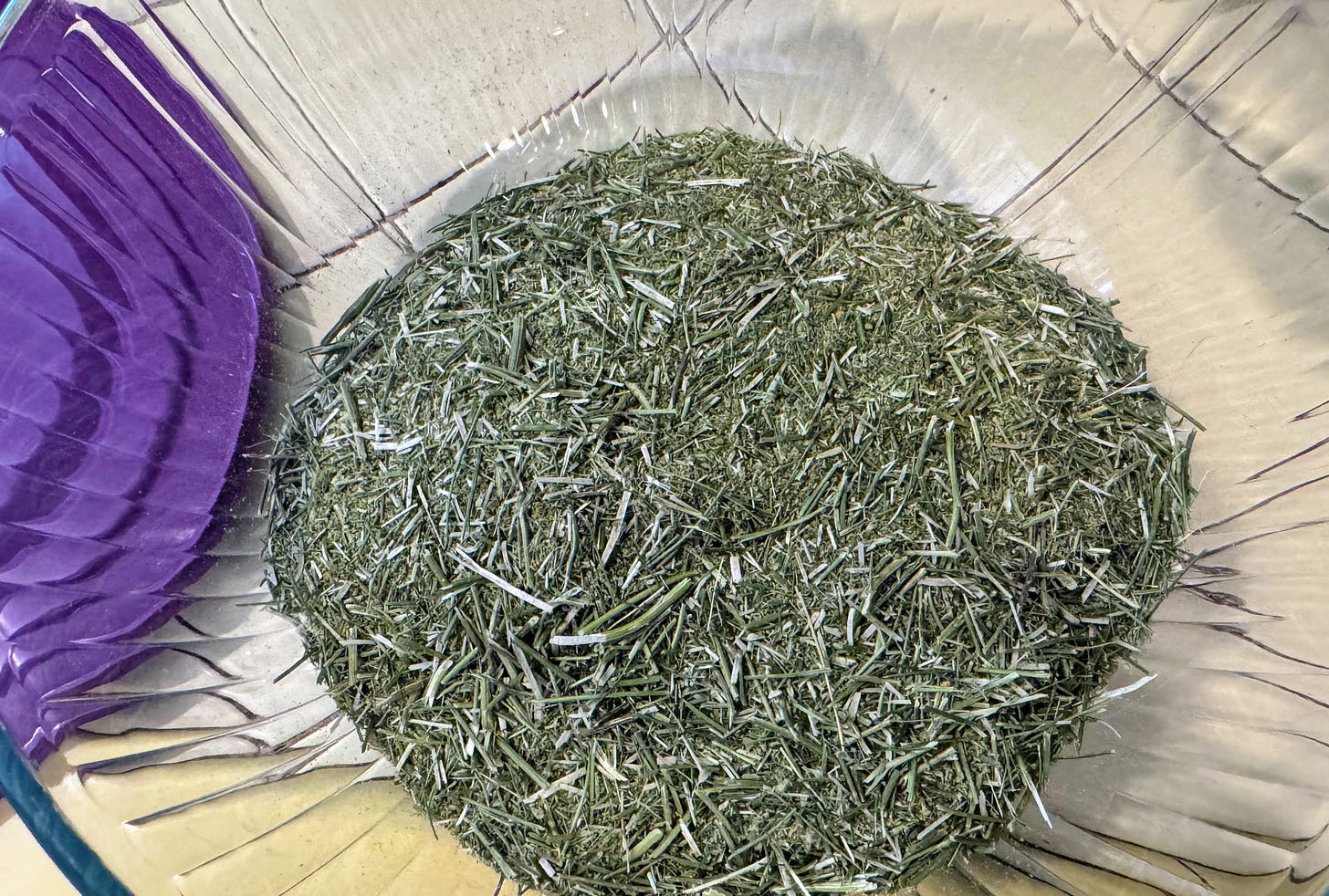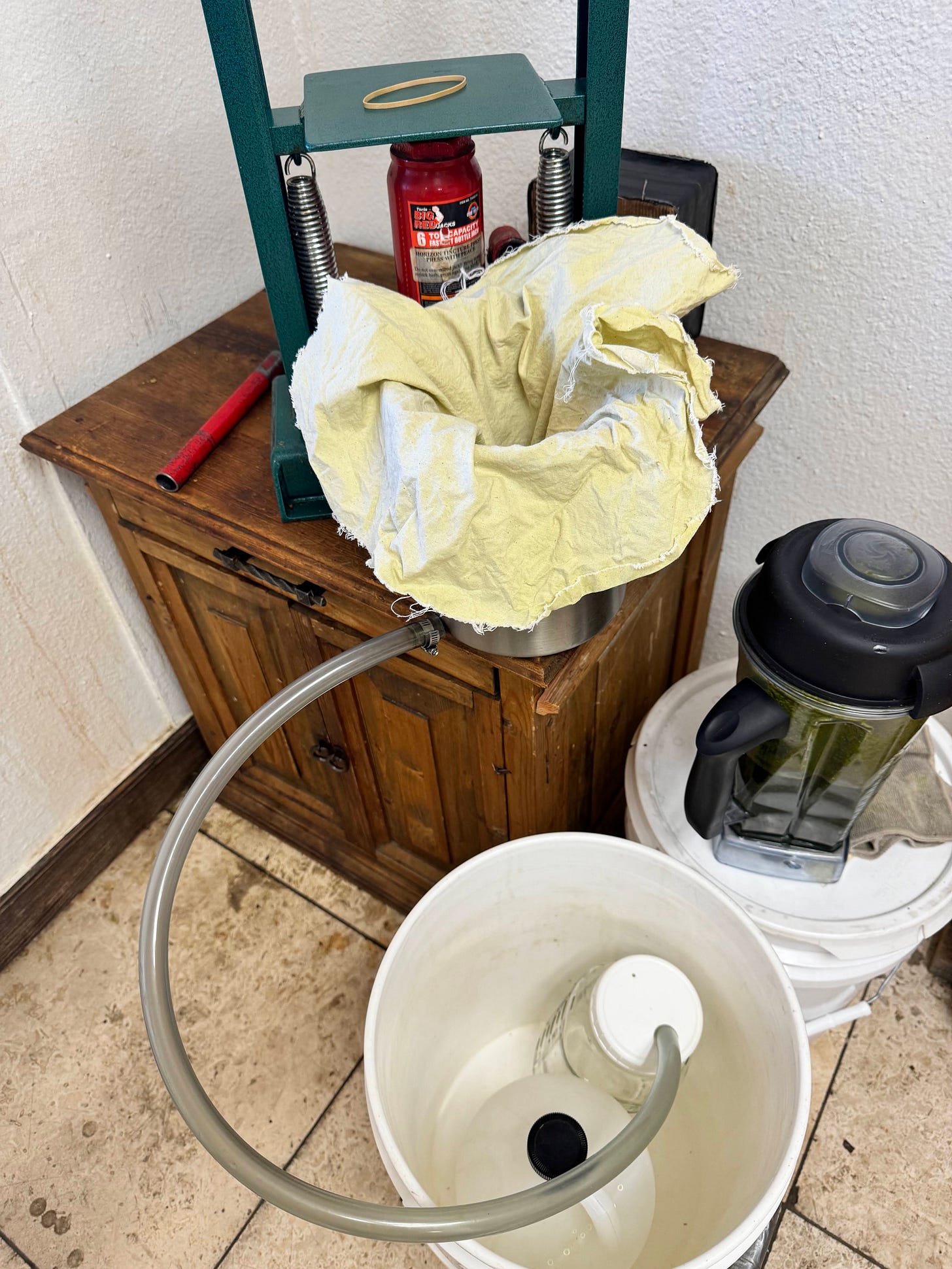Stinknet - Invasive Terror or Message from our Mother?
Learn to appreciate globe chamomile, or stinknet, enough to gather some and prepare an oil infusion for topical use. READ on and I'll tell you how!
Introducing, Stinknet
Somewhere in the last quarter century or so, a little plant called globe chamomile (Oncosiphon piluliferum) began to proliferate in southern California by way of South Africa. It has since spread north and eastward up through the Central Valley to Fresno and over to Las Vegas and through the Mojave and Sonoran deserts to Phoenix and now down to Tucson, AZ.
Most importantly, it is moving rapidly and this has frightened many people earning itself the label of “terrible invasive”.
Also commonly known as stinknet - derived from its various common names in South Africa alluding to its odor (which isn’t too stinky if you ask me) - this plant has recently been promoted to Public Enemy #1 within the world of ‘invasive plant mania’.
Although there is such a thing as relatively new plants coming in and proliferating at a rapid rate of acceleration relative to other annual or short-lived perennial plants in disturbed or over-grazed areas, we must begin to realize that our ideas of “invasive” are most certainly relative to our perspective.
The cognitive dissonance du jour is to imagine, er, accept as fact, that what we “know” (ie. intellectual superiority) about something is what is the “truth” (re: as fact). Unfortunately, this sort of mentality around “invasive plants” can be quite aggressive and may include practices (often officially endorsed, if not licensed and federally funded) of spraying harmful, toxic chemicals on plants that are considered, well, harmful, I guess?

Chamomile or Not Chamomile, that is the Question…
So let’s start here. This is not chamomile, the genial plant of the northern gardens that gets trampled under foot and always come back with a smile. That is our Matricaria recutita, aka German chamomile, very similar to Chamaemelum (Anthemis) nobile, - botanists love to change names incessantly - but in a different genus nonetheless.
So, to be clear, globe chamomile is related to chamomile (both German and Roman) as they are all in the Aster family (along with thousands of other plants) and all are in the subgenus of Anthemidae (again, along with nearly 2000 other plants).
So to say a plant is related, even if correct, botanically, it doesn’t really mean they are very similar, although they can be.
One important trait to point out is that globe chamomile lacks the white petals of German or Roman chamomile and is instead comprised of a purely discoid head (no ray flowers).
To confuse matters further, globe chamomile was once a Matricaria species, so older sources may label it as such. In fact, one listed synonym is M. discoidea which is the current name for pineapple weed a native chamomile lookalike which also lacks white ray flowers. From a forager’s perspective, pineapple weed has a more genial aroma and flavor rendering it more palatable and a plant which one could consider as a “food”. Globe chamomile, however, has a much stronger aroma and bitter taste.

Until very recently, the above plant, pineapple weed, would be the only representative one might find in the winter in our lower Sonoran desert. However, most recently, globe chamomile has become exceptionally prolific whereas pineapple weed is almost nowhere to be found.
What to Do About it?
Off the bat, admittedly, my experience with globe chamomile is quite limited. I’ve been observing the plant, mostly at a distance for about 5 years now. I intended to get to working with it right away in anticipation of it being similar to pineapple weed (which I have used as a similar replacement to whole plant chamomile preparations; ie. more bitter, more liver action, a little less aromatic sedative effect than chamomile flowers). But once I got into the available literature, I thought this plant was a little more suspect for internal use (I intend to explore that further). So I’ve shifted to focusing on topical use.
With that in mind, I quickly realized that this is an excellent opportunity to teach people how to make an effective topical remedy that can be safely applied to a potential wide array of concerns.
As a locally abundant resource (especially metro areas of the Southwest), which many have vilified and see as a pest and a burden, we can flip the narrative in a way that invites participation and provides potential utility as a benefit.
IF people were to focus on globe chamomile as an active participant with Nature, then perhaps they may learn something additional that is not in the script for ‘fighting the invasives’.
But if they are actively removing globe chamomile, it may nonetheless produce the desired effect.
With a little instruction, organization and persistence, this could be a common ingredient in all local herbalists’ repertoire. Over time, with consistent use, the knowledge of the plant and its applications will only grow.
I am inviting everyone here to participate by either sharing this with someone who lives near the proliferation of globe chamomile, or if you do so yourself, then go out and find some globe chamomile to gather (at any stage, so long as you can find it) so you can follow the procedure below to make your own oil infusion to experiment with, explore and give away to any and all who are willing to test it and provide feedback.
How to Make an Oil Infusion with Globe Chamomile, aka Stinknet
Now for the fun part…
I will start with the explanation of each step, then proceed to list out the steps in a brief outline, like a recipe.
Next you’ll see a sequence of photos demonstrating the process.
So if you learn one way or another, you can skip through the more thorough explanatory version right into the outline and photos (but you’ll all probably be back up to the explanation for clarification so good luck to you!).
I’m going to begin on the assumption that you have either gathered or found in your possession, some dry globe chamomile (see photo above for comparison).
PLEASE! Don’t buy this herb! That misses the whole point!
Okay, it’s fine to purchase it from a wildcrafter - that’s great (no, I don’t have any for sale). But the main focus here is to draw attention to it as an asset while simultaneously thinning the population (this is a relatively slow process, all around; but one we need to start asap).
So you have yourself some dry globe chamomile. First step is to crush it into small pieces. This can be done quite easily with a Vitamix and their dry goods pitcher (the shorter version of the two).
Simply pulse the machine (older models) or let it run a few seconds up to full speed then stop and repeat again, and maybe once more.
The purpose of grinding the herb (NOT into a powder) is to increase the surface area AND reduce the volume.
By increasing the surface area we can now get at more of the herb with our primary solvent - alcohol (aka ethyl alcohol). I like organic cane sugar (190 proof) but Everclear brand is find (or anything that is nearly pure alcohol - 95%).
This part is very important as it will create an exceptional product which brings out the best of the remedy for its topical applications.
Do NOT use a lower proof alcohol as it will introduce water back into the herb (once we mix them) which will not only produce a lower quality extraction, but can also more easily contaminate the oil infusion.
If you can’t get 190 proof alcohol in your state (eg. UT), you may be able to have it shipped or team up with an out of state herbalist who has your address (wink-wink).
As for reducing the volume of the herb, this is key as we want to infuse the qualities of the herb into the vegetable oil at a ratio that we’d expect to optimize extraction. This is generally 1:5 (1 part by weight of herb to 5 parts by volume of oil).
If you leave the herb in large or long pieces, you’ll need a lot more oil to cover it thus increasing your ratio and ultimately diluting the infusion.
So, let’s say you have 4oz of dry herb, fully processed and ground into small pieces (less than 1/4” on average); see the photo above.
Place the herb in a glass bowl with a lid (in a pinch a large canning jar could do but you’ll need to mix in a bowl first, glass or metal preferred).
Next we are going to macerate this herb for a minimum of 8 hours (24 is preferred) in approximately 50-75% volume of alcohol by weight of herb.
With 4oz of herb we can multiply by .50 (50%) - 4oz x .5 = 2oz; or .75 (75%) - 4oz x .75 = 3oz.
Measure out 3oz of 190 proof alcohol and begin slowly adding it to the ground herb. Add about half then stir it up trying to get all the herb fully moistened. Add another .5oz and stir some more. Need more? Then add another .5oz. If necessary, add the final .5oz and stir to fully integrate the alcohol into the herb.
Once finished, place the lid on the glass bowl and set aside with the following written on a note adhered to the bowl: “Oncosiphon pilulifera, 4oz herb, (time of day)”.
Set it aside for a minimum of 8hr up to 24hr.
Meanwhile, prepare the vegetable oil that you’ll need. With a ratio of 1:5 we are going to multiply the amount of herb by weight (4oz) by the multiple of the preceding ratio: 4oz x 5 = 20oz - this is our total vegetable oil needed.
If you had 1oz of herb, then you’d use 5oz of vegetable oil (*much easier to use at least 2-3oz of herb for this process).
When the 8-24hr is up, then pull our your Vitamix or kitchen blender. Note the capacity of your blender (volume) before adding all the herb and oil to make sure it’ll all fit in one batch. IF NOT, then you have to carefully portion out the herb and the oil to make sure each batch is close to 1:5. Otherwise, the oil may not blend well in the batch with less oil.
Here’s where the magic happens.
Pour some oil into the bottom of the pitcher. Then add all the herb to the pitcher (if appropriately sized). Now pour the remainder of the vegetable oil on top (I prefer ultra premium olive oil).
Make sure the blender isn’t on high speed to start and turn the blender ON.
Slowly increase the speed until it’s on full speed, full power.
Now let it run until the blender becomes warm to the touch.
With a batch of 4-6oz of herb in a 64oz Vitamix pitcher, this takes about 4.5-6 minutes, depending on the room temperature.
Once the blender is quite warm to the touch (approximately 180F) then turn off the blender. The infusion is complete.
Final step is to separate the oil from the marc (the spent herb). This can be done a variety of ways, but any way will involve some kind of filter. A tight weave muslin works well but will be really slow the first 1-2 pressings so it may be wise to break it in first. You can also use a bandana, a paint filter bag, or a nylon nut milk bag. Cheese cloth is less preferable, in my opinion, as it is expensive and very porous so unless you want fine particles in your infusion, you will likely need to filter it twice. That said, fine particles are not really a problem other than for aesthetics.
You will need to set up something to hold the muslin (a sieve with handles may work) over a bowl that will receive the oil poured through the cloth.
Once you figure this out, then pour the oil slurry into the cloth, over the sieve, and give it time to percolate through. This may take several steps and an hour or two depending on the tightness of your cloth and the amount of oil slurry you have.
Once all the oil has been poured into and through the cloth, you can begin handling it by bringing the 4 corners of the cloth together. If the oil is not likely to overflow the edges of the cloth, then begin slowly twisting the bolus of slurry remaining in the cloth. This must be done slowly so it doesn’t get pushed over the edges with the herb back into your oil.
Slowly continue working on the twisting and squeezing out what you can. You will reach a point of significantly diminished returns on your effort. That is when you know you’re done.
For some herbs, I do hold onto the marc (herb remaining in the cloth) to be used topically as a poultice. I’ll leave that up to you to decide. But if you’re concerned about introducing the seeds into your garden, I would suggest not composting the marc as it may contain viable seeds.
Now you have an oil infusion that can be used topically in the following ways, or made into a salve with the addition of beeswax.
Potential Topical Applications of Globe Chamomile Oil Infusion:
**It’s best to TEST a small amount first on non-irritated skin and wait 15 minutes for a response when using an herbal oil for the first time if there’s any suspicion of a potential reaction
Sore muscles
Injuries to ligaments, tendons
Injuries to muscles or bone
Arthritis
Rashes, skin irritations (especially with dry skin)
Sores, swollen masses
Burns, bites, stings
Nerve tissue damage
Preventative for sunburn
Emollient
NOTE: I have limited experience with this plant and there is very limited literature on the topical applications of the oil infusion. But the above are a list of potential applications from what I understand and have experienced already.
To Recap…
Outline - How to Make an Oil Infusion with Globe Chamomile
Start with dry herb (3-6oz)
Grind herb into 1/4” or less pieces but NOT powder
Moisten herb with 190 proof alcohol; 4oz of herb, then around 3oz of alcohol
Mix well and let sit, covered, for 8-24hr
Prepare vegetable oil at 1:5 ratio; 4oz of herb, then 20oz of olive oil (my preference)
Add oil and herb to blender pitcher (eg. Vitamix) and blend until very warm
Stop the blender once warm (around 4.5-6 minutes)
Pour the oil slurry through a cloth and sieve to separate the oil from the marc (spent herb)
Apply the oil infusion, as needed
Oil infusion can also be combined with beeswax to make salve
Steps to Make Globe Chamomile Oil Infusion in Photos
Step 1: Grind Herb down to 1/4” or less, on average; set into glass bowl with cover
Step 2: Moisten Herb in Alcohol and set aside for 8-24hr
Step 3: Combine the Herb and Olive Oil in the blender pitcher and Blend the Alcohol-moisten Herb with Olive Oil until Warm
Step 4: Strain the Oil Slurry through a Cloth to Separate the Oil from the Herb
Once fully pressed, now you have your oil infusion, ready to use!
Scroll up for a list of potential applications for this Globe Chamomile Oil Infusion.









Great article! I've not yet met this Stinknet, but am familiar with the 'invasive' speak that seems to necessitate further harm thru the spraying of nasty chemicals. There's an area I go to often where Fish & Game/Forest Service (?) have been trying to plant Pine trees, etc. You can see where they spray. The blocks of land desolate, aside from the giant thistles that refuse to die. I appreciate your pointing out that our language, i.e. invasive plants, doesn't also take into effect that we've altered the landscape so much as to make it perfectly hospitable for such beings to stake a place there! Beautiful looking oil too.
I have stared at the Globe Cham. growing in my yard each season and wondered why it is there. It is here because we altered our environment and now we want to go to war with it? Maybe it is helping our soil? Maybe it is an undiscovered remedy that afflicts humans. Such as one of the many afflictions that is caused by our disregard for the natural environment. I appreciate this article so much!